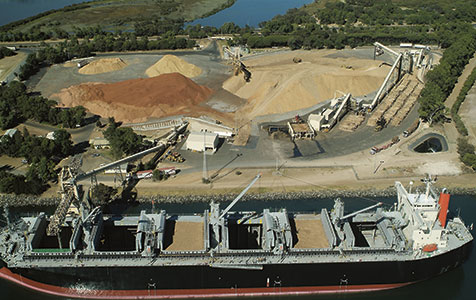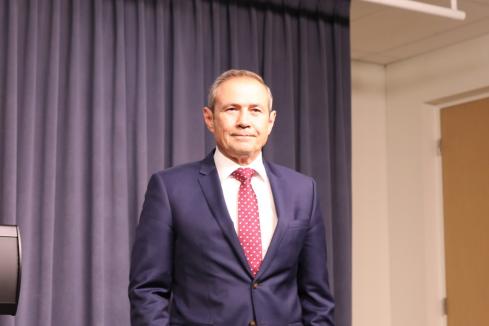Increasing demand for hardwood plantation products has boosted the outlook for the much-maligned industry in Western Australia, but whether companies can capitalise on new growth will depend on how much suitable land they can access.


Increasing demand for hardwood plantation products has boosted the outlook for the much-maligned industry in Western Australia, but whether companies can capitalise on new growth will depend on how much suitable land they can access.
Hardwood plantations have been doing it tough since 2009, with the industry confronted by the collapse of managed investment schemes, a decline in woodchip exports (their main product), falling commodity prices, the loss of major clients in Japan after the 2011 tsunami, and increased competition for land use.
The total value of Australian woodchip exports has fallen by 42 per cent during the past five years, in large part due to increased supply from competitors in Vietnam and Thailand and Australian companies reducing their plantation holdings.
Exports of woodchips out of Albany Port have dropped from a high of 1.6 million tonnes in the financial year 2008-2009 to between 1.1mt and 1.3mt each following year, while exports out of Bunbury Port have averaged 1.3mt per annum for the past five years, with a low of 1.1mt recorded in 2008-2009 and a peak of 1.5mt in 2010-2011.
Resurgent demand for woodchips has led to ports in the South West increasing exports in the past four months, and the industry believes it’s a trend that will continue.

WA Plantation Resources (WAPRES) chief executive Ian Telfer said export activity at Albany and Bunbury ports was encouraging, and supported claims of renewed growth in the hardwood market.
“There was a decline in (export) trend over the last 12 months. That’s now turning around quite quickly. In a reasonably short period of time we’re getting a significant surge in demand,” Mr Telfer said.
Whether hardwood exports can claw back from its downward trend, which has continually fallen since 2007, will depend largely on companies’ ability to secure enough land for more viable plantations.
The size of WA managed plantations, which are located in the South West and Great Southern regions, has fallen considerably since 2009 due to a number of crops originally destined for MIS not being re-established.
Forest Industries Federation WA executive director Melissa Haslam said the future of the industry would depend on how much suitable new land at a reasonable distance to ports and with adequate rainfall was available to plantation companies at prices they could afford.
Ms Haslam said companies currently were reducing their crop management areas as they gave up on unviable first crops.
To supply increasing demand, however, they now faced strong competition from agriculture for new tracts of suitable land to grow additional holdings.
“They’ve been through a couple of years of a perfect storm, (but) now the demand for woodchips into China and India is increasing, Japan are starting to take more woodchips again, the Australian dollar’s finally moving in the right direction, so I would say there’s definitely light at the end of the tunnel,” Ms Haslam said.
Investor interest
Major Japanese entities, which have long been a part of the local hardwood scene, are among those that believe demand for hardwood products is set to increase.
Trade businesses and a new wave of global institutional investors, who have secured many of the tree crops the MIS collapse left behind, are also interested players.
Japanese trading house Marubeni owns WA Plantation Resources (WAPRES), while fellow trading house Mitsui owns Bunbury Fibre Plantations and its sister business, Bunbury Fibre Exports. And a joint venture of Oji Holdings, Senshukai and NYK Line owns Albany Plantation Forest Company and its sister business, Albany Plantation Export Company.
The state’s other major hardwood plantation companies – New Forests and Australian Bluegum Plantations, through its parent company Global Forest Partners – are owned by international investment funds.
Jostling for land
While these companies clearly believe there’s a future in the industry, convincing farmers it’s worthwhile giving land over to single or preferably double hardwood crop rotations has been a difficult sell.
Mr Telfer said persuading landowners to lease their land or sell to plantations, particularly after many were burned by the unrealised tax benefits and profit promises of MIS, was part of a larger marketing dilemma.
“People affected by the (MIS) collapse … think that maybe the industry is dying. We’re now seeing that that’s not the case, the fundamentals are very strong, but our challenge is actually to turn around that confidence of landowners to see that trees will be an ongoing part of the landscape and it’s an industry that will be sustainable,” Mr Telfer told Business News.
Mr Telfer said the other part of the problem was facilitating a move from traditional arrangements, where farmers leased their land in return for quarterly payments indexed every year, to one where they entered a crop share agreement and waited until harvest for a percentage of the profit.
To make this riskier proposition attractive to farmers, Mr Telfer said WAPRES would focus on high rainfall areas with good soil, which increased the chances of a higher yield and bigger payout, and required less land.
Mr Telfer said buying land was also an option, but this strategy came with risks of its own.
“We have to be careful how we do that,” he said.
“We don’t want to be seen as buying out traditional agricultural land from communities, which was an issue the MIS had – the social infrastructure within communities being affected by companies buying out land for trees.”
Meanwhile, plantation company New Forests has increased its land holdings by buying the trees left over from the demise of MIS.
In December 2013, New Forests announced the completion of an 80,000-hectare acquisition of eucalyptus trees on separate land parcels primarily in Victoria, South Australia and WA, bringing its total land managed in WA to 100,000ha, 60 per cent of which is plantation tree crops.
New Forests was able to acquire the trees from the administrators of the now defunct MIS Great Southern Plantations, following a Supreme Court decision allowing the purchase of the trees on freehold land.
Future possibilities
In addition to increased demand for woodchip exports, another possible opportunity could come from other uses of hardwood, including biofuels, which New Forests has said would be a part of its future market development.
Mid last year, New Forests managing director David Brand said it was developing opportunities to turn timber and waste material into biomass energy and liquid fuels in a collaborative agreement with the Clean Energy Finance Corporation.
While the Abbott government has placed the CEFC’s future in doubt, in a November 2013 statement Mr Brand said New Forests was still focused on exploring biofuels as a potential growth market.
“We will also focus on market development for veneer logs, as well as exploring opportunities for domestic energy, biofuels or other processing,” he said.


















